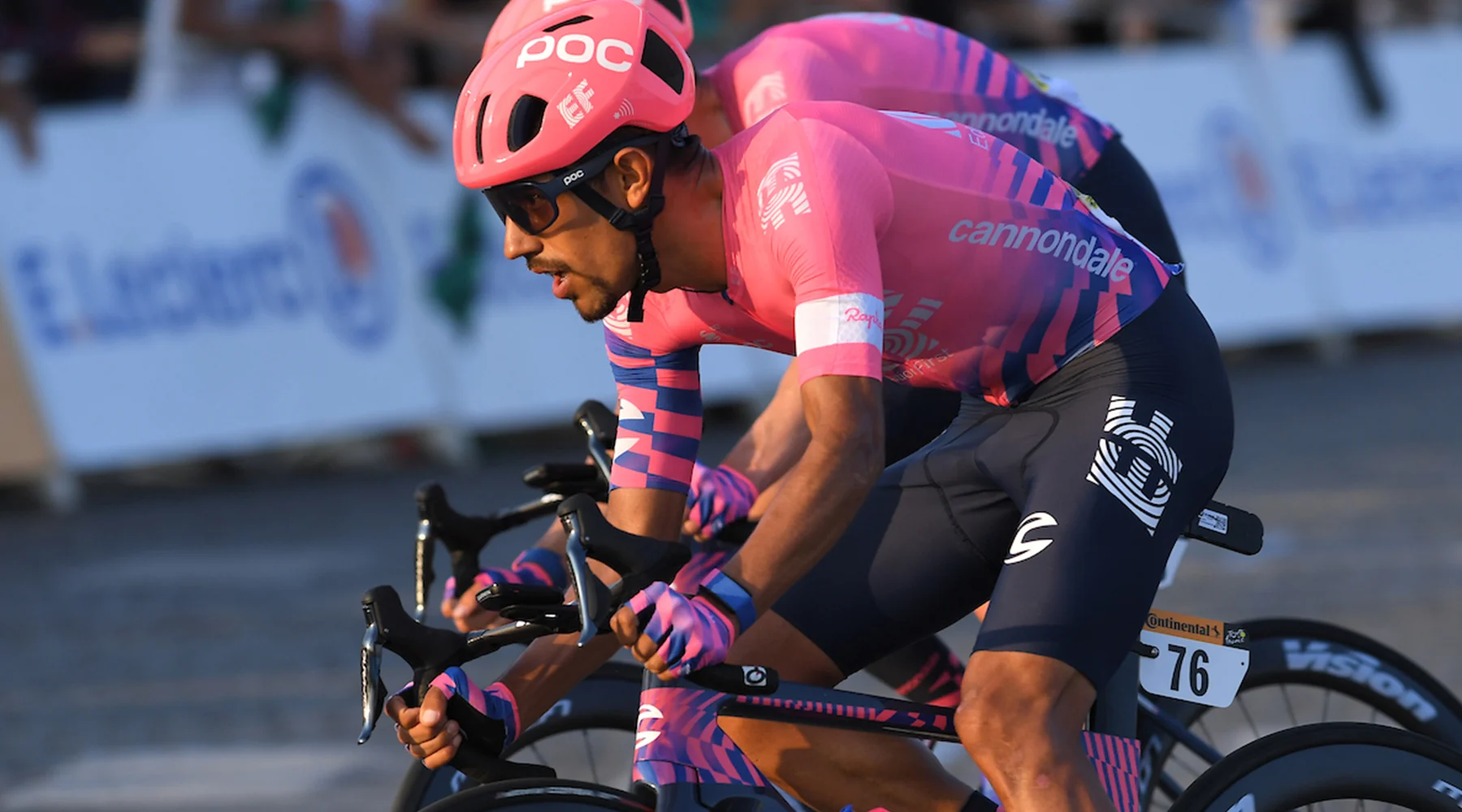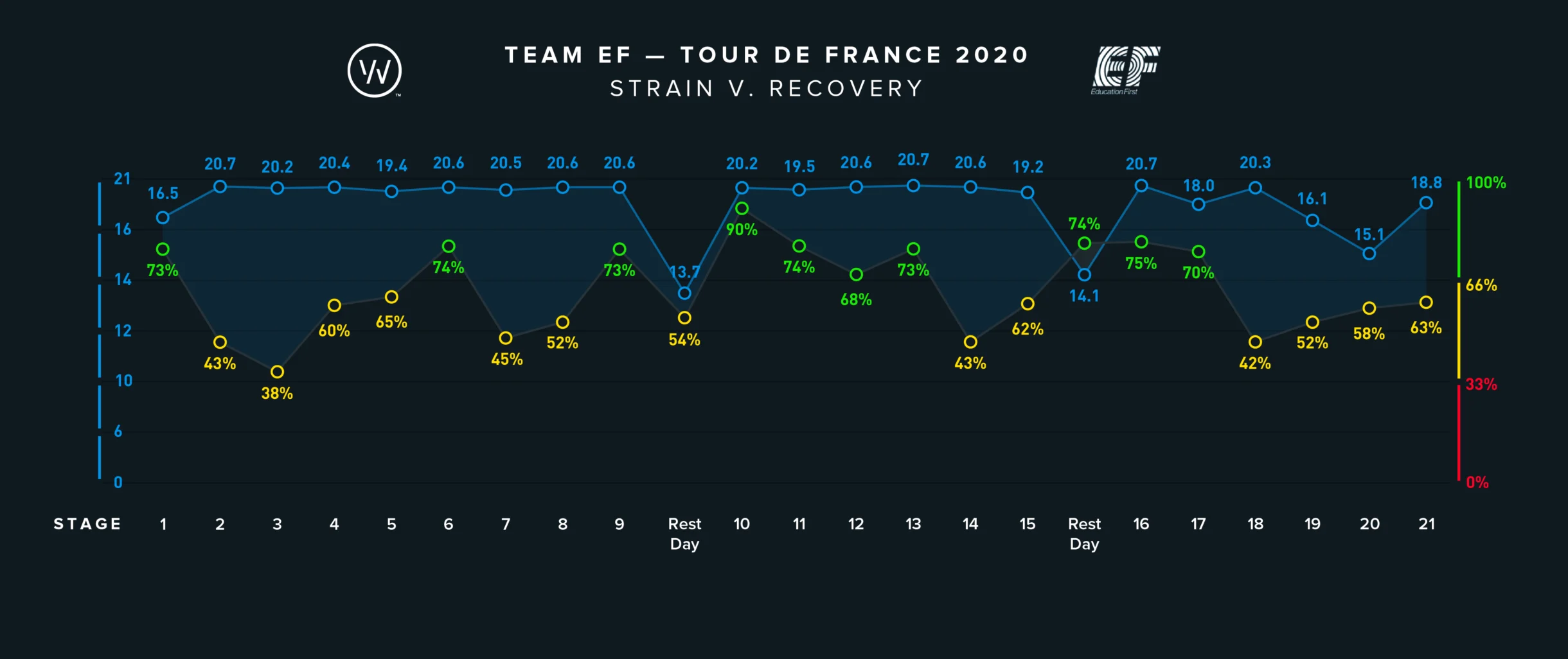Topics
- Article
- Cycling
How Strenuous is the Tour de France? Plus Other Biometric Data Insights

WHOOP tracked pro cyclists’ heart rates, sleep, strain, and HRV during the Tour de France.
Tour de France Cycling Data: Strain, Resting Heart Rate, HRV, Sleep & More
“The Tour de France is arguably the pinnacle of endurance sport performance. WHOOP has allowed us to quantify both the strain and daily recovery of some of the fittest athletes in the world, and the numbers are impressive,” said Kevin Sprouse, Head of Medicine for EF Pro Cycling. The EF squad finished 4th out of 22 teams at the 2020 Tour de France, and was the top team overall for 7 of the race’s 21 stages. Below we’ll share many of the insights gained from monitoring these athletes’ physiological data while competing in one of the most grueling events in sports.
3 Weeks of All-Out Strain
WHOOP quantifies the strain (cardiovascular load) your body takes on each day on a 0-21 scale. Through the Tour’s 21 stages (which spanned just 23 days total with only a pair of days off), the EF riders posted average day strains of 20 or more 13 times. Additionally, on other days they averaged 19.5, 19.4, 19.2, 18.8 and 18.0 (see graphic below). To put that into perspective, WHOOP classifies anything above 18 as an “all-out” effort, meaning the EF athletes basically pushed themselves to the limit nearly every time they got on the bike, for 3 weeks straight. It’s also important to note that the WHOOP strain metric is highly individualized--so if an elite athlete and an average athlete do the same thing, the activity will almost certainly cause less strain for the better athlete. Considering that the EF riders are among the most physically fit humans on the planet (with the ability to take on significantly more cardiovascular load than the average person), the fact that they still put up strains in the 20s on a regular basis is somewhat mind-boggling.

THE AVERAGE DAILY WHOOP STRAIN AND RECOVERY FOR EF RIDERS DURING THE 2020 TOUR DE FRANCE.
Phenomenal Resting Heart Rate and HRV
Curious just how fit the EF team is? On the day the Tour began, the team members’ average resting heart rate was 42 beats per minute (the American Heart Association says that anything between 60 and 100 bpm is normal to push the standard amount of oxygen through your bloodstream), and their average heart rate variability was 139 milliseconds (the average HRV for all WHOOP members is 64 ms). As the Tour progressed, it naturally took a toll on these impressive metrics. After the first week, the team’s average RHR had risen to 51 bpm, and its average HRV had dropped to 73 ms. However, it took just one day of rest for these numbers to bounce back. Following the riders’ day off prior to Stage 10, the EF team’s average RHR and HRV were actually better than they were before the race began, at 40 bpm and 152 ms, respectively. The team also averaged a 90% WHOOP recovery (a measure of the body’s readiness to take on strain) after the first rest day, better than the 73% on the morning of Stage 1.
Incredible Recovery
It’d be natural to assume that day after day of all-out strain would significantly hurt the team’s recovery each morning, but that was not the case with the EF riders. “I’ve seen lots of 20.7 [strains],” said Sprouse, “rarely is it lower than 20. What’s just as amazing is the fact that recovery scores tend to be good as well, often 55% and higher. That is a huge testament to the amazing staff we have supporting these guys at the Tour. From the finish line to bedtime, everything is set up to encourage recovery so that they can perform again the following day.” In fact, over the entire 23-day Tour, the team’s average daily recovery never dipped into the red (33% and below). Amazingly, it even stayed in the green (67% and higher) 4 times following stages where the average strain was 20+ (see above).
Pushing Heart Rate to the Limits
Another indication of just how hard these riders pushed themselves is the amount of time they spent at close to their max heart rate. For example, in Stage 8, Neilson Powless was on the bike for a little more than 4 hours. His average heart rate was 165 bpm, and he spent 51% of the time at 80-90% of his max heart rate. Amazingly, he was in the 90-100% of max heart rate zone for 38% of the stage, or 1 hour and 35 minutes.
The Power of Sleep
After crushing themselves on the road all day, effective sleep is obviously an essential aspect of recovery. Powless, in particular, was spectacular at this. The team averaged just shy of 8 hours per night during the Tour, however Powless regularly got about half an hour more than his teammates did. On the night of the race’s second rest day (between Stages 15 and 16), Powless got just over 9 hours of sleep. He also spent 5:51 (a whopping 64% of his time asleep) in what we call the “restorative stages” of sleep (REM and deep sleep). People usually only spend about 40-45% of their sleep time in these stages when the body repairs itself. Similarly, following the first rest day, Powless slept for 7:59 and spent 5:02 in REM and deep sleep (63%). This helped him achieve a 92% recovery the next morning. Photo Credits: Getty Images, Jered and Ashley Gruber